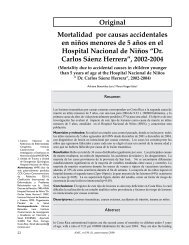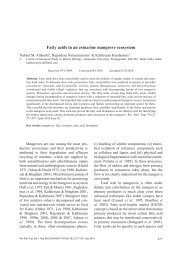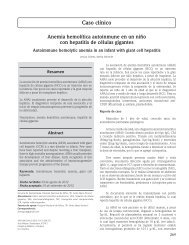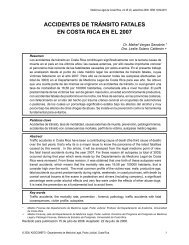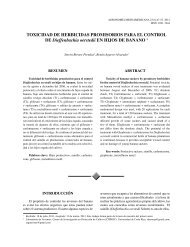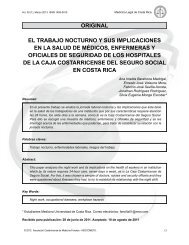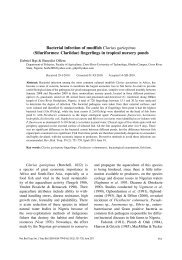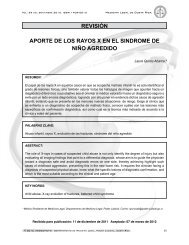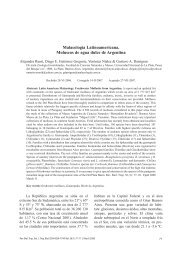Evaluation of Local Infiltration with Bupivacaine for Pain ... - SciELO
Evaluation of Local Infiltration with Bupivacaine for Pain ... - SciELO
Evaluation of Local Infiltration with Bupivacaine for Pain ... - SciELO
Create successful ePaper yourself
Turn your PDF publications into a flip-book with our unique Google optimized e-Paper software.
ISSN 0001-6002/2011/53/4/199-204<br />
Acta Médica Costarricense, ©2011<br />
Colegio de Médicos y Cirujanos<br />
Original<br />
<strong>Evaluation</strong> <strong>of</strong> <strong>Local</strong> <strong>Infiltration</strong> <strong>with</strong> <strong>Bupivacaine</strong> <strong>for</strong><br />
<strong>Pain</strong> Management after Partial Bilateral<br />
Salpingectomy<br />
(Evaluación de la infiltración local de bupivacaina en el manejo del dolor<br />
post salpingectomía parcial bilateral)<br />
Mariella Fajardo-Arcia 1 , Leonardo Orozco-Saborío 2 , Gerardo Montiel-Larios 3<br />
Abstract<br />
Objective: the efficacy <strong>of</strong> locally applied bupivacaine <strong>for</strong> decreasing<br />
postoperative pain was evaluated, in patients who underwent mini-laparotomy<br />
partial bilateral salpingectomy.<br />
Methods: A total <strong>of</strong> 100 women, scheduled <strong>for</strong> surgical sterilization, were<br />
randomized to either an intervention group that received 2.5mg <strong>of</strong> bupivacaine<br />
in the mesosalpinx and 2.5 mg in the fallopian tube stump, or a control group<br />
that received no intervention. Postoperative pain was measured one and four<br />
hours after the procedure, using the visual analogue scale (VAS, 0-10 cm), and<br />
the need and quantity <strong>of</strong> postoperative analgesia was determined. The Student<br />
t-test was used to compare averages, and all analyses were made <strong>with</strong> the<br />
Stata 10.0 statistical s<strong>of</strong>tware, a critical point <strong>of</strong> 0.05 (p≤ 0.05) was defined as<br />
statistically significant.<br />
1. Gynecology and Obstetrics<br />
Resident. Hospital de las<br />
Mujeres Dr. Adolfo Carit Eva<br />
(HOMACE).<br />
2. Gynecologist, HOMACE.<br />
3. Chief <strong>of</strong> the Gynecology<br />
Department, HOMACE. CCSS.<br />
Hospital de las Mujeres Dr.<br />
Adolfo Carit Eva. Gynecology<br />
Department.<br />
Clinical Investigation Unit,<br />
Hospital de las Mujeres, Dr.<br />
Adolfo Carit Eva.<br />
Abbreviations: VAS, Visual-<br />
Analog Scale.<br />
Correspondence: Leonardo<br />
Orozco S. P.O. Box 11619-<br />
1000. San José, Costa Rica<br />
E-mail: loscr@yahoo.com<br />
Results: Scores on the visual analogue scale (VAS cm) <strong>for</strong> the bupivacaine<br />
group were 4.7 and 2.6, compared to 5.3 and 2.6 <strong>for</strong> the control group, one<br />
and four hours after surgery respectively (p> 0.05). Application <strong>of</strong> bupivacaine<br />
significantly reduced the patients´ requests <strong>for</strong> a second dose <strong>of</strong> analgesics one<br />
hour after surgery (p
Female sterilization, also known as tubal<br />
occlusion, has been one <strong>of</strong> the most used<br />
contraceptive methods worldwide. 1,2 More than one<br />
million reproductive age women have been sterilized,<br />
and it is estimated that since 1982, more than 100<br />
million women, just in developing countries, will look<br />
<strong>for</strong> sterilization. 3<br />
Sterilization has evolved similarly to other<br />
surgical procedures; many techniques have been<br />
developed in an ef<strong>for</strong>t to simplify the procedure, from<br />
the per<strong>for</strong>mance through a mini-laparotomy, to<br />
laparoscopic sterilization techniques. 4<br />
In developed countries, laparoscopy is<br />
per<strong>for</strong>med, based on its safety and effectiveness.<br />
However, in developing countries, mini-laparotomy is<br />
used because <strong>of</strong> low available resources, per<strong>for</strong>ming<br />
696 procedures in 2006 <strong>for</strong> example, at the<br />
Gynecology Department <strong>of</strong> the Hospital de las<br />
Mujeres in San José, Costa Rica. 7<br />
Several studies have been per<strong>for</strong>med to<br />
evaluate the improvement <strong>of</strong> postoperative pain <strong>with</strong><br />
local anesthetics after partial bilateral salpingectomy.<br />
Most <strong>of</strong> them showed that these anesthetics diminish<br />
pain scale scores, besides decreasing the need <strong>for</strong><br />
postoperative analgesia. 8-27 However, most <strong>of</strong> studies<br />
used laparoscopy as the approach method, which is<br />
why the objective <strong>of</strong> this study was to evaluate the<br />
efficacy <strong>of</strong> local bupivacaine infiltration to reduce<br />
postoperative pain in patients subject to minilaparotomy<br />
partial bilateral salpingectomy.<br />
Materials and methods<br />
This was designed as a randomized, double<br />
blinded, study. Previously being approved by the<br />
Institutional Ethics Committee, the In<strong>for</strong>med Consent<br />
was obtained, and 100 patients were enrolled in this<br />
study. These patients were women who were<br />
programmed <strong>for</strong> surgical sterilization in the<br />
ambulatory surgery program <strong>of</strong> the Gynecology<br />
Department <strong>of</strong> the Hospital de las Mujeres. The<br />
inclusion criteria were: women older than 18 years old<br />
and who met the necessary paperwork <strong>for</strong> surgical<br />
sterilization. Women excluded were those <strong>with</strong> a<br />
history <strong>of</strong> tubal surgery, intra-abdominal adhesions,<br />
chronic pelvic pain, psychiatric disorders or mental<br />
retardation, and a history <strong>of</strong> any type <strong>of</strong> allergic<br />
reactions to local anesthetics. This trial´s sample<br />
population was chosen based on another study, 28<br />
which determined that 57 women were necessary to<br />
detect, <strong>with</strong> a 95% probability and 90% power, a 25%<br />
reduction in the visual analogue scale after 2 hours.<br />
After the acknowledge that <strong>with</strong> 57 women<br />
the above mentioned indicators were obtained, and<br />
taking into account the number <strong>of</strong> groups to be<br />
compared in this study, a sample <strong>of</strong> 100 randomized<br />
women was obtained, equally distributed to both<br />
treatment groups.<br />
The making <strong>of</strong> the randomizing list was<br />
per<strong>for</strong>med <strong>with</strong> the aid <strong>of</strong> computer s<strong>of</strong>tware,<br />
assigning 50 participants to the intervention group<br />
and the other 50 to the control group (Figure 1). To<br />
hide this assignation, sealed envelopes were used,<br />
which were later opened by the operating room´s<br />
anesthesiologist once the patient was anesthetized.<br />
The participants and physicians who applied the visual<br />
analogue scale were blinded to the group assignations<br />
(Figure 1).<br />
All proceedings were realized under a general<br />
anesthesia standardized regimen. Be<strong>for</strong>e anesthetic<br />
induction, patients were pre-medicated <strong>with</strong> 10mg <strong>of</strong><br />
metoclopramide, 1mg <strong>of</strong> midazolam and 0.75<br />
micrograms/kg <strong>of</strong> fentanyl, the latter was used as<br />
analgesia.<br />
Standard anesthetic induction was per<strong>for</strong>med<br />
<strong>with</strong> prop<strong>of</strong>ol at a 2mg/kg dose, 5mg <strong>of</strong> atracurium<br />
and 100mg <strong>of</strong> succinylcholine were applied to<br />
facilitate endotracheal intubation. All participants<br />
were subject to mechanical ventilation, and<br />
maintenance <strong>of</strong> anesthesia was per<strong>for</strong>med <strong>with</strong><br />
sev<strong>of</strong>lurane and oxygen. Intraoperative monitoring<br />
was made <strong>with</strong> clinical standards. Anesthesia was<br />
stopped at the end <strong>of</strong> the surgery, and the blocking<br />
was not reverted. Modified Pomeroy partial bilateral<br />
salpingectomy was the technique used <strong>for</strong> surgical<br />
sterilization. The intervention group received 5 cc <strong>of</strong><br />
0.5% bupivacaine (5mg/ml flask presentation) in each<br />
Fallopian tube as follows: 2.5 cc in the mesosalpinx<br />
Acta méd. costarric. Vol 53 (4), October-December 2011
Infiltración local de bupivacaina / Fajardo-Arcia M y cols<br />
Excluded N: 7<br />
Urticari<strong>for</strong>m rash after<br />
anesthetic induction: 1<br />
Declined to participate: 1<br />
Did not fulfill anesthetic<br />
protocol: 2<br />
Variation in surgical<br />
technique: 3<br />
Control group<br />
N: 43<br />
Users who gave consent<br />
N: 100<br />
Randomized patients<br />
N: 100<br />
Control group 50 Intervention group 50<br />
Excluded N: 4<br />
Bladder lesion: 1<br />
Variation in surgical<br />
technique: 3<br />
Control group<br />
N: 46<br />
Figure 1. Randomizing and group assignment flowchart.<br />
and 2.5 cc in the surgical stump. The control group did<br />
not receive any drug in the Fallopian tubes.<br />
In the hospital room, the evaluation <strong>of</strong> the<br />
visual analogue scale (VAS, 0-10cm) began after 1 and<br />
4 hours <strong>of</strong> the surgical intervention.<br />
The applied regimen <strong>for</strong> those patients who<br />
requested analgesia in hospital room was, a 75mg<br />
dose <strong>of</strong> Intramuscular dicl<strong>of</strong>enac was given. If a<br />
second request was made, 50mg <strong>of</strong> subcutaneous<br />
tramadol was applied, and in case a third request <strong>for</strong><br />
analgesia was made, 15mg <strong>of</strong> subcutaneous morphine<br />
was given. Postoperative analgesia was applied by the<br />
nursery staff, previously prescribed by a physician and<br />
recorded in the patient´s file, and according to the<br />
expressed requirements <strong>for</strong> each patient. The time <strong>of</strong><br />
application and the type <strong>of</strong> analgesia were recorded.<br />
For the data analysis, patients were<br />
characterized by estimating the frequencies and<br />
proportions <strong>for</strong> the qualitative variables, and<br />
estimating the averages and standard deviations as<br />
descriptive measures <strong>for</strong> the quantitative variables <strong>for</strong><br />
each group. Characteristics were compared <strong>with</strong> the<br />
Student t-test <strong>for</strong> the quantitative variables, and <strong>with</strong><br />
the chi-square test <strong>for</strong> the qualitative variable<br />
distribution between groups.<br />
A comparison <strong>of</strong> the visual analogue scale<br />
between groups after 1 and 4 hours was made, by<br />
comparing the averages using the Student t-test. All<br />
analyses were made <strong>with</strong> the Stata 10.0 statistical<br />
s<strong>of</strong>tware, defining a statistically significant critical<br />
point <strong>of</strong> 0.05 (p≤0.05).<br />
Results<br />
From April 1 st until September 9 th , 2008, a<br />
total <strong>of</strong> 100 participants agreed the In<strong>for</strong>med<br />
Consent.<br />
A total <strong>of</strong> eleven participants were excluded,<br />
seven <strong>of</strong> them were part <strong>of</strong> the control group, and<br />
their causes were: an urticarial eruption after the<br />
anesthetic induction, one patient declined to<br />
participate, two patients did not fulfill the anesthetic<br />
protocol, and three patients had variations in the<br />
surgical technique. For the intervention group, four<br />
patients were excluded: one had a bladder lesion, and<br />
three had variations in the surgical technique. This<br />
resulted in 43 patients in the control group and 46 in<br />
the intervention group.<br />
There were no significant differences in the<br />
sociodemographic characteristics or clinical history<br />
between both groups (Table 1; Table2). The surgery<br />
length was 17.5 ± 6.1 minutes <strong>for</strong> the bupivacaine<br />
group, and 18.5 ± 5.9 <strong>for</strong> the control group (Table 1<br />
and Table 2).<br />
The VAS score one hour after surgery was 4.7<br />
± 2.7 <strong>for</strong> the bupivacaine group and 5.3 ± 3.2 <strong>for</strong> the<br />
control group (p= 0.30). Four hours after surgery, the<br />
scores were 2.6 ± 2.2 <strong>for</strong> the bupivacaine group and<br />
2.6 ± 2.3 <strong>for</strong> the control group (Figure 2).<br />
An exploratory analysis was made, comparing<br />
the VAS <strong>for</strong> the interventional and control groups one<br />
and four hours after surgery <strong>for</strong> those patients who<br />
did not request analgesia after surgery, <strong>with</strong>out<br />
finding significant differences: 35.7 ± 24.8 <strong>for</strong> the<br />
intervention group and 38.0 ± 29.8 <strong>for</strong> the control<br />
group after one group (p= 0.79); 23.9 ± 5.3 and 17.2 ±<br />
2.8, after four hours, respectively (p= 0.29). When<br />
comparing the magnitude <strong>of</strong> decrease in the VAS <strong>for</strong><br />
patients who did not request analgesia, a significant<br />
difference was seen <strong>for</strong> the control group when<br />
comparing one to four hours after surgery, 38.0 ± 29.8<br />
and 17.2 ± 2.8 respectively (p= 0.01), not so in the<br />
bupivacaine group, 35.7 ± 24.8 after one hour and
Dicl<strong>of</strong>enac<br />
Tramadol<br />
None<br />
Dicl<strong>of</strong>enac<br />
Tramadol<br />
None<br />
Dicl<strong>of</strong>enac<br />
Tramadol<br />
None<br />
Table 1: Comparison <strong>of</strong> the general characteristics <strong>for</strong><br />
patients subject to surgical sterilization.<br />
Hospital de las Mujeres, 2008<br />
Control Group<br />
<strong>Bupivacaine</strong><br />
Group<br />
N Mean SD N Mean SD<br />
Age 43 30.7 7.5 46 30.3 5.8 0.74<br />
Weight 43 62.6 12.4 46 65.6 11.4 0.24<br />
Height 43 154.6 16.4 46 157.4 6.5 0.28<br />
BMI 43 25.8 3.5 46 26.4 4.3 0.52<br />
Gynecoobstetrical history<br />
Pregnancies 43 2.9 1.6 46 2.7 1.3 0.52<br />
Deliveries 43 2.6 1.3 46 2.3 1.2 0.21<br />
Cesarean<br />
Delivery<br />
43 0.3 0.7 46 0.1 0.3 0.17<br />
Abortions 43 0.3 0.6 46 0.4 0.6 0.45<br />
Table 2: Surgical history according to each group, <strong>for</strong><br />
patients subject to surgical sterilization<br />
Non-Exposed<br />
<strong>Bupivacaine</strong><br />
N % N %<br />
Cesarean Delivery 5 31.2 6 35.3<br />
Curettage 4 25.0 5 29.4<br />
Cholecistectomy 3 18.7 0 0.0<br />
Appendectomy 2 12.5 4 23.5<br />
Two or more<br />
cesarean deliveries<br />
2 12.5 0 0.0<br />
Hernioplasty 1 6.2 1 5.9<br />
Cystectomy 0 0.0 1 5.9<br />
Laparotomy 0 0.0 1 5.9<br />
P<br />
23.9 ± 5.3 after four hours (p=0.13).<br />
In the control group, 15.9% <strong>of</strong> participants<br />
requested a second dose <strong>of</strong> analgesia compared <strong>with</strong><br />
2.2% in the bupivacaine group (p˂ 0.03). Furthermore,<br />
the control group had a larger use <strong>of</strong> opioids (n=8)<br />
compared to the bupivacaine group (n=1). No patient<br />
needed a third dose <strong>of</strong> analgesia (Figure 3).<br />
Regarding the elapsed time from surgery to<br />
the first dose <strong>of</strong> analgesia, there was no difference<br />
between the groups (p= 0.76). No adverse effects<br />
were reported because <strong>of</strong> the intervention, and<br />
intraoperative complications or variations in the<br />
surgical technique were not related to the use <strong>of</strong><br />
bupivacaine.<br />
Discussion<br />
Unlike previous studies; which showed an<br />
improvement in pain scales after partial bilateral<br />
salpingectomy; 10, 28, 30 this study, showed no<br />
significant differences in postoperative pain scores<br />
(using the visual analogue scale, one and four hours<br />
after surgery), after applying bupivacaine in the tubal<br />
stumps and mesosalpinx, when per<strong>for</strong>ming minilaparotomy<br />
surgical sterilization.<br />
VAS<br />
cm<br />
First<br />
request<br />
Second<br />
request<br />
Third<br />
request<br />
1 hour 4 hours<br />
Figure 2. Comparison <strong>of</strong> the visual analogue scale according to<br />
the evaluation time between groups, <strong>for</strong> patients subject to<br />
surgical sterilization. Hospital de las Mujeres, 2008<br />
Control patients<br />
Exposed patients<br />
Figure 3. Postoperative analgesic drugs comparison, according to<br />
each group, <strong>for</strong> patients subject to surgical sterilization. Hospital<br />
de las Mujeres, 2008.<br />
Acta méd. costarric. Vol 53 (4), October-December 2011
Remarkably, most studies which proved the<br />
effectiveness <strong>of</strong> a local anesthetic had a laparoscopic<br />
surgical approach, suggesting that dissection <strong>with</strong><br />
mini-laparotomy <strong>of</strong> larger amounts <strong>of</strong> abdominal wall<br />
tissues (during pelvic access), highly influences<br />
postoperative pain.<br />
However, applying bupivacaine was effective<br />
in reducing the needs <strong>for</strong> postsurgical analgesia and<br />
opioid use one hour after surgery, agreeing <strong>with</strong> a<br />
large number <strong>of</strong> studies which showed a variable<br />
decrease in analgesia consumption and the need <strong>for</strong><br />
opioids <strong>for</strong> those patients <strong>with</strong> a local anesthetic. 17-10,<br />
16,17,20 This shows that applying bupivacaine has a<br />
short term benefit after surgery, even though it is not<br />
reflected in the VAS score, as the control group had a<br />
similar reduction in the VAS score to that <strong>of</strong> the<br />
intervention group (Figure 2). This could be explained<br />
if pain´s amount, perception or tolerance is<br />
differentiated.<br />
<strong>Pain</strong> is an emotive personal experience; its<br />
magnitude can only be subjectively described by the<br />
affected person. It is known that pain perception <strong>for</strong><br />
any given subject greatly varies according to<br />
emotional and mood factors; 28,31 in this context it is<br />
known that psychological, cognitive and behavioral<br />
factors have become determinant factors in pain<br />
management. 32-37 This situation has been previously<br />
described, where a lower use <strong>of</strong> morphine one hour<br />
after surgery was described, although VAS scores in<br />
the study period were similar <strong>for</strong> both groups. 38<br />
There are some limitations <strong>for</strong> this trial.<br />
Firstly, although the applied dose was already used in<br />
other studies, 7-10 in Costa Rica it is difficult to measure<br />
drug concentrations, and it depends only on the<br />
surgeon to achieve a homogeneous drug dose.<br />
Secondly, the amount <strong>of</strong> analgesics taken by the<br />
participants after discharge was not recorded,<br />
because this self-report could represent an increased<br />
work <strong>for</strong> the patient. It might be conceivable that<br />
there was a difference in the amount <strong>of</strong> analgesia<br />
taken between both groups. However, since patients<br />
<strong>with</strong> more pain would take more analgesics, the<br />
difference in pain levels should decrease instead <strong>of</strong><br />
Infiltración local de bupivacaina / Fajardo-Arcia M y cols<br />
growing, and it would not be ethical to deny analgesia<br />
to a person in pain.<br />
In conclusion, the fact that mini-laparotomy<br />
partial bilateral salpingectomy is an ambulatory<br />
procedure and that in some cases patients are not<br />
discharged due to pain, it is extremely important to<br />
seek <strong>for</strong> an improvement in postoperative pain relief.<br />
The use <strong>of</strong> bupivacaine by this surgical approach does<br />
not seem to benefit the achievement <strong>of</strong> this goal.<br />
However, it seems effective <strong>for</strong> diminishing the need<br />
<strong>for</strong> postoperative analgesia and the use <strong>of</strong> opioids.<br />
The short effect duration <strong>of</strong> this treatment<br />
could postpone, but not eliminate the need <strong>for</strong> other<br />
analgesics; there<strong>for</strong>e bupivacaine should be seen as<br />
an add-on to therapy, not as a replacement <strong>of</strong><br />
traditional analgesic therapy.<br />
Acknowledgements<br />
To the Anesthesia department <strong>of</strong> HOMACE,<br />
especially to Dr. Leonardo Barquero, Dr. Doris Sánchez<br />
and Lic. Sara Campos <strong>for</strong> cooperating <strong>with</strong> this study.<br />
References<br />
1. Limpaphayom K. Sterilization. CurrOpinObstetGynecol 1991;<br />
3: 501- 509.<br />
2. World Health Organization. Contraceptive use and<br />
commodity cost <strong>of</strong> female sterilization. What health workers<br />
need to know. WHO/ FHE/FPP 1994;94.2.<br />
3. World Health Organization, Task Force on Female<br />
Sterilization, Special programmed <strong>of</strong> Research, Development<br />
and Research Training in Human Reproduction.<br />
Minilaparotomy or laparoscopy <strong>for</strong> sterilization. Am J Obstet<br />
Gynecol 1982; 143:645-652.<br />
4. Wheeless CR. Outpatient laparoscope sterilization under<br />
local anesthesia. Obstet Gynecol 1972; 39:767-770.<br />
5. Osathanondh V. Suprapubic mini-laparotomy, uterine<br />
elevation technique: simple, inexpensive and out-patient<br />
procedure <strong>for</strong> interval female sterilization. Contraception<br />
1974;10:251-262.<br />
6. Uchida H. Uchidatubalsterilization. Am J ObstetGynecol<br />
1975; 121:153-158.<br />
7. Centro de estadística del Hospital de la Mujer Adolfo Carit<br />
Eva, San José Costa Rica.<br />
8. Van Ee R, Hemrika DJ, de Blok S. Effects <strong>of</strong> ketopr<strong>of</strong>en and<br />
mesosalpinx infiltration on postoperative pain afeter<br />
laparoscopic sterilization. Obstet Gynecol 1996; 88: 568-72.<br />
9. Alexander CD, Wetchler BV, Thompson RE. Bupivacaína<br />
infiltration <strong>of</strong> the mesosalpinx in ambulatory surgical
laparoscopic tubal sterilization. Can J Anaesth 1987; 34: 362-<br />
5<br />
10. Kaplan P, Freund R, Squires J, Herz M. Control <strong>of</strong> immediate<br />
postoperative pain <strong>with</strong> topical bupivacaine hydrochloride<br />
<strong>for</strong> laparoscopic Falope ring tubal ligation. Obstet Gynecol<br />
1990: 798-802<br />
11. Smith BE, MAcPherson GH, de Jorge M, Griffith JM. Rectus<br />
sheath and mesosalpinx block <strong>for</strong> laparoscopic sterilization.<br />
Anaesthesia 1991; 46:875-7<br />
12. Wheatley SA, Millar JM, Jadad AR. Reduction <strong>of</strong> pain after<br />
laparoscopic sterilization <strong>with</strong> local bupivacaine: a<br />
randomized, parallel, double- blind trial. Br J Obstet<br />
Gynaecol 1994; 101: 443-6<br />
13. Tool Al, Kammerer-Doak DN, Nguyen CM. Posoperative pain<br />
relief following laparscopic tubal sterilization <strong>with</strong> silastic<br />
bands. Obstet Gynecol 1997; 90: 731-4<br />
14. Koetsawang S, Srisupandit S, Apimas SJ, Champion CB. A<br />
comparative study <strong>of</strong> topical anesthesia <strong>for</strong> laparoscopic<br />
sterilization <strong>with</strong> the use <strong>of</strong> tubal ring. Am J Obstet Gynecol<br />
1984; 150: 931- 3.<br />
15. Barclay K, Calvert JP, Catling. Analgesia after laparocopic<br />
sterilization. Effect <strong>of</strong> 2% lignocaine gel applied to Filshie<br />
clips. Anaesthesia 1994; 49: 68-70.<br />
16. Ezed UO, Shoulder VS, Martin JF. <strong>Local</strong> anaesthetic on<br />
doubledblind controlled trial. Lancet 1995; 346:82-5<br />
17. Fiddes TM, Williams HW. Herbison GP. <strong>Evaluation</strong> <strong>of</strong><br />
postoperative analgesia following laparoscopic application<br />
<strong>of</strong> Filshie clips.Br J Obstet Gynecol 1996; 103:1143-7.<br />
18. McKenzie R, Phitayokorn P, Uy NTL. Topical etidocaine<br />
during laparoscopic tubal occlusion <strong>for</strong> postoperative pain<br />
relief. Obstet Gynecol 1986; 67:447-9<br />
19. Baram D, Smith C, Stinson S. Intraoperative topical<br />
etiodocaine <strong>for</strong> reducing postoperative pain after<br />
laparoscopic tubal ligation. J Reprod Med 1990; 35:407-10<br />
20. Loughney AD, Sarma V, Ryall EA. Intraperitoneal bupivacaine<br />
<strong>for</strong> the relief <strong>of</strong> pain following day case laparoscopy. Br J<br />
Obstet Gynaecol 1994; 101: 449-51.<br />
21. Benhamou D, Narchi P, Mazoit JX, Fernandez H.<br />
Postoperative pain after local anesthesics <strong>for</strong> laparoscopic<br />
sterilization. Obstet Gynecol 1994; 84:877-80.<br />
22. Callesen T, Hijort D, Mogensen T. Combined field block and<br />
i.p. instillation <strong>for</strong> pain management after laparoscopic<br />
sterilization. Br J Anaesth 1999; 82: 586-90.<br />
23. Mohammed E, Lahsae M, Alborzi S, Vafaei H, Heinrich E.<br />
Comparative, double- blind, randomized, placebo-controlled<br />
trail <strong>of</strong> intraperitoneal <strong>of</strong> bupivacaine and lidocaine <strong>for</strong> pain<br />
control after diagnostic laparoscopy. J Am<br />
AssocGynecollaparosc 2003; 10:311-315<br />
24. Hunter A, Fogarty P. Transcervical analgesia <strong>for</strong> laparoscopic<br />
sterilization. Br J Obst Gynecol. 1996, 103: 378-380<br />
25. Luscombe FE, Puonder D, Geraghty AV, Bevan JR.<br />
Percevicalintrafallopian bupivacaine instillation to reduce<br />
postoperative pain after laparoscopic tubal sterilization.<br />
Journal <strong>of</strong> Obstetrics and Gynaecology. 1989, 10: 145-148<br />
26. Wheatley SA, Millar JM, Jadad AR. Reduction <strong>of</strong> pain after<br />
laparoscopic sterilization <strong>with</strong> local bupivacaine:<br />
randomized, parallel, double-blind trial. British Journal <strong>of</strong><br />
obstetrics and gynecology 1994; vol 101, 5:443-446<br />
27. Visalyaputra S, Lertakyamanee J, Pethpaisit N, SomprakitP,<br />
Parakkamodom S, Suwanapeum P. Intraperitoneallidocaine<br />
decreases intraoperative pain during postpartum tubal<br />
ligation. AnesthAnalg 1999; 88:1077-80.<br />
28. Kelly MC. An assessment <strong>of</strong> the value <strong>of</strong> intraperitoneal<br />
bupivacaine <strong>for</strong> analgesia after laparoscopic sterilization.<br />
BJOG1996,103: 837-839.<br />
29. Dionne RA, Khan AA, Gordon SM. Analgesia and COX-2<br />
inhibition. Clin Exp Rheumatol 2001; 19(6 Suppl 25):S63-70.<br />
30. Knight YE, Goadsby PJ. The periaqueductal grey matter<br />
modulates trigeminovascular input: a role in migraine?<br />
Neuroscience 2001; 106:793-800.<br />
31. Ashpal K, Fisher K, Chabot J, Coderre TJ. Differential effects<br />
<strong>of</strong> NMDA and group I mGluR antagonists on both<br />
nociception and spinal cord protein kinase C traslocation in<br />
the <strong>for</strong>malin test and a model <strong>of</strong> neuropathic pain in rats.<br />
Clin J <strong>Pain</strong> 2001; 17:178-86.<br />
32. Eastwood JD. The folly <strong>of</strong> ef<strong>for</strong>t: ironic effects in the mental<br />
control <strong>of</strong> pain. Int J ClinExpHypn 1998; 46 :19.<br />
33. Fillingim RB, Maixner W, Kincaid S, Sigurdsson A, Harris MB.<br />
<strong>Pain</strong> sensitivity in patients <strong>with</strong> temporomandibular<br />
disorders: relationship to clinical and psychosocial factors.<br />
Clin J <strong>Pain</strong> 1996; 12:260-9.<br />
34. Field HC. Brainsterm control <strong>of</strong> spinal pain trasmissor<br />
neurons. Ann Rev Physiol 1978; 40:217-48.<br />
35. Fillingim RB. Sex differences in temporal summation but not<br />
sensorydiscriminative processing <strong>of</strong> thermal pain. <strong>Pain</strong> 1998;<br />
75:121-7.<br />
36. Foster NE, Baxter F, Walsh D, Baxter GD, Allen JM.<br />
Manipulation <strong>of</strong> transcutaneous electrical nerve stimulation<br />
variables has no effect on two models <strong>of</strong> experimental pain<br />
in humans. Clin J <strong>Pain</strong> 1996; 12:301-10.<br />
37. Stanik-Hutt JA, Soeken KL, Belcher AE, Fontaine DK, Gift AG.<br />
<strong>Pain</strong> experiences <strong>of</strong> traumatically injured patients in a<br />
critical care setting. Am J Crit Care 2001;10 :252-9.<br />
38. Fredman B, Jedeikin R, Olsfanger D, Flor P, Gruzman A.<br />
Residual pneumoperitoneum: a cause <strong>of</strong> postoperative pain<br />
after laparoscopic cholecystectomy. Anesth Analg 1994;79:<br />
152–4.<br />
Translated by: Dr. Javier Estrada Zeledón<br />
Acta méd. costarric. Vol 53 (4), October-December 2011




